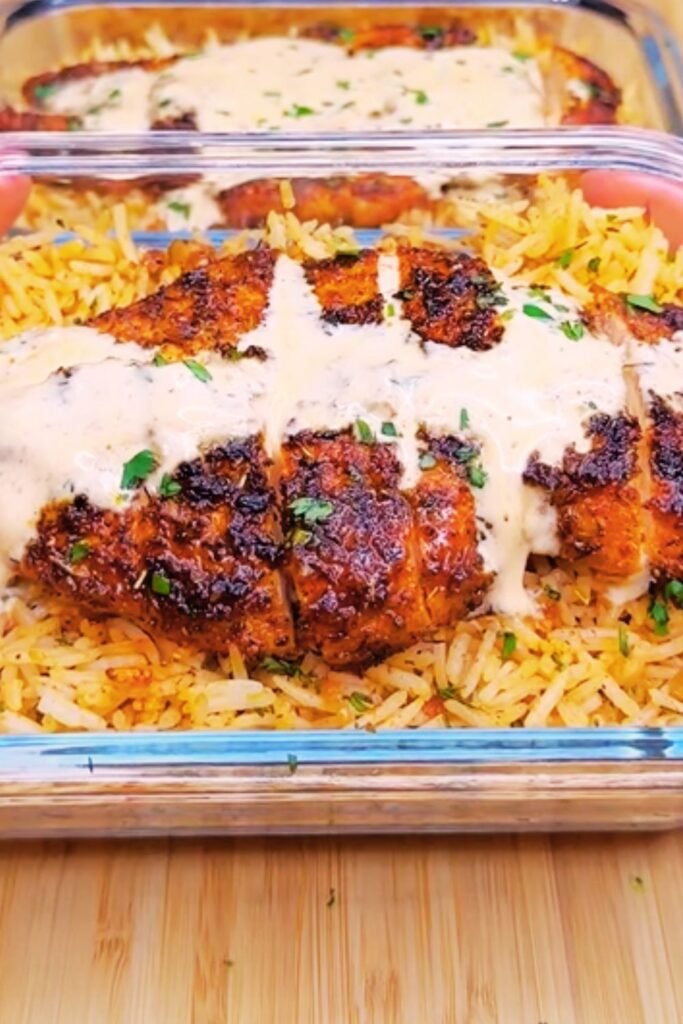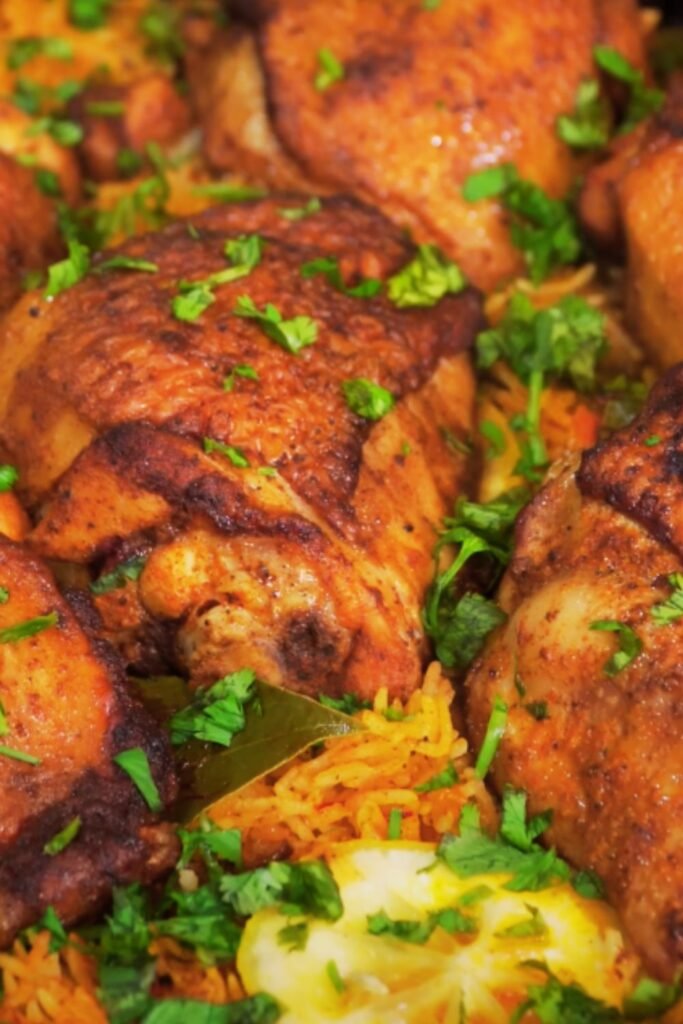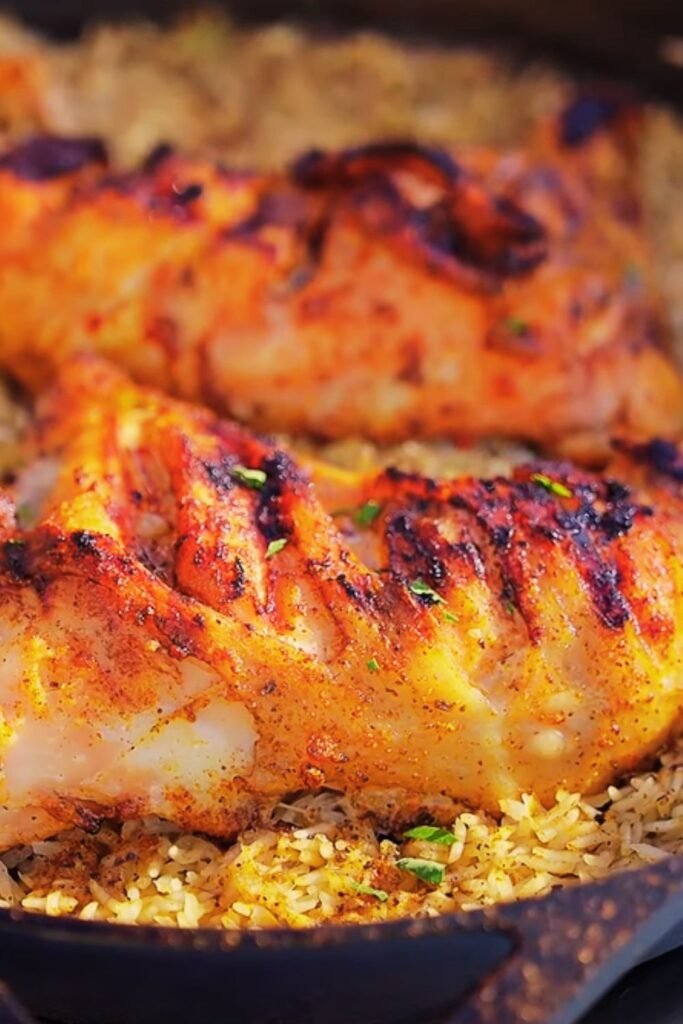There’s something magical about the moment when a perfectly seasoned Cajun chicken and rice skillet hits your table, steam rising with aromas of paprika, thyme, and garlic. The vibrant colors, the promise of spicy comfort, and knowing it all came together in one pan—it’s enough to make anyone’s mouth water! As someone who’s spent years perfecting this Southern classic, I’m thrilled to share my foolproof recipe that delivers authentic Cajun flavors without requiring culinary school credentials.
When I first attempted Cajun cooking, I was intimidated by the complex flavor profiles and worried about balancing the heat. Several burnt rice bottoms and over-spiced chicken breasts later, I’ve learned the secrets to creating that perfect harmony of flavors and textures that makes this dish a staple in my home. Whether you’re cooking for a hungry family or meal-prepping for the week ahead, this one-pan wonder delivers maximum flavor with minimal cleanup.
What Makes Cajun Cuisine Special?
Originating from the French-speaking Acadian settlers of Louisiana, Cajun cooking is characterized by its hearty, rustic approach and bold use of spices. Unlike its refined cousin Creole cuisine (often described as “city cooking”), Cajun food is country cooking at its finest—resourceful, flavorful, and designed to feed many mouths with accessible ingredients.
The “holy trinity” of Cajun cooking—bell peppers, onions, and celery—forms the aromatic base of countless dishes, including our star recipe. When these vegetables hit a hot skillet with a splash of oil, the sizzle and fragrance alone tell you something extraordinary is happening. Add the signature spice blend of paprika, cayenne, thyme, and oregano, and you’ve captured the essence of Louisiana countryside cooking.
Essential Ingredients for Authentic Flavor
Before diving into the cooking process, let’s explore the key players that make this dish sing:
The Cajun Holy Trinity:
- Bell peppers: Provide sweetness and vibrant color
- Onions: Create aromatic depth and natural sweetness
- Celery: Adds texture and subtle savory notes
The Protein:
- Chicken thighs: I prefer these over breasts for their moisture and flavor, but either works wonderfully
- Andouille sausage (optional): For an extra layer of smoky, spicy authenticity
The Grains:
- Long-grain rice: Provides the perfect texture that separates nicely when cooked
- Chicken broth: Infuses the rice with flavor as it cooks
The Signature Seasonings:
- Paprika (sweet and smoked)
- Cayenne pepper (adjustable to your heat preference)
- Dried thyme and oregano
- Garlic powder
- Onion powder
- Black pepper
- Salt

Making Your Own Cajun Seasoning
While store-bought options exist, nothing beats a freshly mixed batch of Cajun seasoning. Here’s my go-to blend that perfectly balances heat, earthiness, and aromatics:
| Ingredient | Amount | Flavor Contribution |
|---|---|---|
| Paprika | 2 tablespoons | Color, mild sweetness |
| Smoked Paprika | 1 tablespoon | Smokiness, depth |
| Garlic Powder | 1 tablespoon | Savory notes |
| Onion Powder | 1 tablespoon | Sweet undertones |
| Dried Oregano | 2 teaspoons | Herbal complexity |
| Dried Thyme | 2 teaspoons | Earthy, aromatic |
| Cayenne Pepper | 1/2-2 teaspoons | Heat (adjust to preference) |
| Black Pepper | 1 tablespoon | Warmth, complexity |
| Salt | 1 tablespoon | Flavor enhancer |
Mix these ingredients thoroughly and store in an airtight container for up to three months. This blend will transform not just this recipe but countless others. I’ve used it on roasted vegetables, grilled fish, and even popcorn for a spicy snack!
The Perfect Cajun Chicken & Rice Skillet Recipe
Now that we understand the foundations, let’s dive into the main event. This recipe serves 4-6 people generously, and leftovers (if you’re lucky enough to have any) reheat beautifully.
Ingredients
For the Chicken:
- 1.5 pounds boneless, skinless chicken thighs (or breasts), cut into 1-inch pieces
- 2 tablespoons Cajun seasoning (homemade or store-bought)
- 1 tablespoon olive oil
- 1 tablespoon butter
For the Holy Trinity and Rice:
- 1 large green bell pepper, diced
- 1 large onion, diced
- 2 celery stalks, finely chopped
- 4 garlic cloves, minced
- 1 jalapeño, seeded and minced (optional, for extra heat)
- 1.5 cups long-grain white rice, rinsed and drained
- 3 cups low-sodium chicken broth
- 1 can (14.5 oz) diced tomatoes, undrained
- 2 bay leaves
- 1 tablespoon Worcestershire sauce
- 1 teaspoon dried thyme
- Salt and freshly ground black pepper to taste
For Serving:
- 4 green onions, sliced
- Fresh parsley, chopped
- Lemon wedges
- Hot sauce (for those who like extra heat)
Step-by-Step Cooking Method
- Season the chicken: In a large bowl, toss chicken pieces with 1 tablespoon of Cajun seasoning until evenly coated. Let this sit for at least 15 minutes—this brief marination time makes a world of difference in flavor development.
- Prepare your workspace: Measure and prep all remaining ingredients before heating your skillet. This “mise en place” approach prevents overcooking while you’re searching for ingredients.
- Sear the chicken: Heat a large, deep skillet (12-inch is perfect) or Dutch oven over medium-high heat. Add oil and butter. When butter is melted and bubbling, add the seasoned chicken in a single layer, working in batches if necessary to avoid crowding. Cook for 2-3 minutes per side until golden brown but not fully cooked through. Transfer to a plate and set aside.
- Sauté the holy trinity: In the same skillet, add the bell pepper, onion, and celery. Cook until softened, about 5 minutes, scraping up any flavorful browned bits from the bottom of the pan. Add garlic and jalapeño (if using) and cook for another 30 seconds until fragrant.
- Toast the rice and seasonings: Add rinsed rice to the vegetable mixture along with the remaining Cajun seasoning. Stir constantly for about 2 minutes—this toasting step adds depth to the final dish by bringing out the nutty qualities of the rice and blooming the spices.
- Add liquids and aromatics: Pour in the chicken broth, diced tomatoes with their juice, Worcestershire sauce, and add the bay leaves and thyme. Stir well and season with a pinch of salt and black pepper. Bring to a boil.
- Return the chicken: Once boiling, add the partially cooked chicken and any accumulated juices back to the skillet. Give everything a good stir.
- Simmer to perfection: Reduce heat to low, cover tightly, and simmer for 20-25 minutes until rice is tender and liquid is absorbed. Resist the urge to stir during this time—this helps create that desirable texture contrast between the crispy bottom layer and fluffy top layer.
- Rest before serving: Remove from heat and let stand, covered, for 5 minutes. This resting period allows the moisture to distribute evenly throughout the dish.
- Finish and serve: Remove bay leaves, fluff the rice with a fork, and garnish with sliced green onions and chopped parsley. Serve with lemon wedges and hot sauce on the side.

Troubleshooting Common Issues
Even experienced cooks encounter challenges with one-pot rice dishes. Here are solutions to common problems:
| Issue | Probable Cause | Solution |
|---|---|---|
| Rice still crunchy | Not enough liquid or cooking time | Add 1/4 cup more hot broth, cover and cook 5 more minutes |
| Rice too wet/mushy | Too much liquid or overcooked | Remove lid, increase heat slightly and cook uncovered 3-5 minutes |
| Burning on bottom | Heat too high or thin-bottomed pan | Lower heat and use a heavy-bottomed skillet or Dutch oven |
| Bland flavor | Under-seasoned or old spices | Add more Cajun seasoning and fresh herbs at the end |
| Too spicy | Heavy hand with cayenne | Serve with cooling agents like sour cream or avocado |
Variations to Keep Things Interesting
One of the beautiful aspects of Cajun cooking is its adaptability. Here are some of my favorite ways to switch up this basic recipe:
Seafood Sensation
Replace chicken with 1 pound of peeled, deveined shrimp and 8 ounces of andouille sausage. Add the shrimp during the last 5 minutes of cooking to prevent overcooking.
Vegetarian Delight
Substitute chicken with 2 cans of drained, rinsed beans (kidney, black, or cannellini work well) and use vegetable broth instead of chicken broth. Add extra vegetables like corn, zucchini, or mushrooms for heartiness.
Creamy Comfort
Stir in 1/2 cup of heavy cream and 1 cup of shredded cheddar or pepper jack cheese after the rice is cooked. Let it melt for a few minutes before serving for an indulgent twist.
Extra Authentic
Add 1/2 pound of sliced andouille sausage along with the chicken, and incorporate 1 cup of okra (sliced) during the last 10 minutes of cooking time.

Nutritional Profile
For those watching their macros or simply curious about what’s on their plate, here’s the approximate nutritional breakdown per serving (assuming 6 servings):
| Nutrient | Amount | % Daily Value* |
|---|---|---|
| Calories | 385 | – |
| Protein | 26g | 52% |
| Carbohydrates | 42g | 14% |
| Dietary Fiber | 3g | 12% |
| Sugars | 4g | – |
| Fat | 12g | 18% |
| Saturated Fat | 3.5g | 18% |
| Cholesterol | 85mg | 28% |
| Sodium | 580mg | 24% |
| Potassium | 520mg | 15% |
| Vitamin A | – | 20% |
| Vitamin C | – | 80% |
| Calcium | – | 6% |
| Iron | – | 15% |
*Percent Daily Values based on a 2,000 calorie diet
Make-Ahead and Storage Tips
This dish shines as a meal prep option:
Refrigeration: Store cooled leftovers in airtight containers for up to 4 days. The flavors actually deepen overnight, making next-day servings especially delicious.
Freezing: For longer storage, portion fully cooled rice and chicken into freezer-safe containers and freeze for up to 3 months. Thaw overnight in the refrigerator before reheating.
Reheating: For best texture, reheat in a skillet with a splash of broth or water to restore moisture. Microwave reheating works in a pinch—cover with a damp paper towel and heat in 1-minute intervals, stirring between.
Serving Suggestions
Transform your Cajun chicken and rice from a simple meal into a memorable dining experience with these serving ideas:
- Accompany with a fresh green salad dressed with lemon vinaigrette to cut through the richness
- Serve with crusty French bread for sopping up any remaining sauce
- Add a side of collard greens or roasted Brussels sprouts for extra vegetables
- Top with sliced avocado for creamy contrast to the spicy flavors
- Set out a variety of hot sauces for diners to customize their heat level
- Serve with cold sparkling water with lemon slices to refresh the palate
For a complete Louisiana-inspired meal, consider starting with a simple cup of gumbo or a small serving of shrimp remoulade, and finishing with bananas foster or bread pudding for dessert.
Tips from My Kitchen to Yours
After countless iterations of this recipe, I’ve discovered several tricks that elevate it from good to unforgettable:
- Don’t skip the chicken searing step: Those browned bits on the bottom of the pan are flavor gold for the rice.
- Fresh vs. dried herbs: While dried herbs work wonderfully in the cooking process, adding fresh herbs at the end brightens the whole dish.
- Rice rinsing matters: Don’t skip rinsing the rice—it removes excess starch and prevents gumminess.
- Heat management: A consistent, gentle simmer is crucial for properly cooked rice. Too hot, and you’ll burn the bottom before the top cooks; too cool, and you’ll end up with soggy rice.
- Rest period: Those 5 minutes of resting time at the end aren’t optional—they’re essential for moisture distribution and texture development.
- Skillet selection: A heavy cast iron skillet or Dutch oven with a tight-fitting lid works best for even heating and heat retention.
- Taste and adjust: Cajun seasoning varies widely in salt content and heat level. Always taste and adjust your final dish before serving.
Frequently Asked Questions
Can I use brown rice instead of white rice? Yes, but you’ll need to adjust cooking time and liquid. Brown rice typically requires about 45 minutes to cook and needs approximately 1/2 cup more liquid. Add the chicken later in the cooking process to prevent it from becoming tough.
How can I reduce the sodium in this recipe? Use low-sodium broth, make your own Cajun seasoning without salt (adding just a pinch to taste), and use fresh or no-salt-added canned tomatoes. You can always add a little salt at the table if needed.
Is this recipe gluten-free? The basic recipe is gluten-free, but always check your Worcestershire sauce and broth labels, as some brands contain gluten. If making for someone with celiac disease, ensure all your spices are certified gluten-free to avoid cross-contamination.
Can I make this in an Instant Pot? Absolutely! Use the sauté function for the initial steps, then cook on high pressure for 5 minutes with a quick release. Let it rest for 5 minutes after releasing pressure before serving.
How spicy is this dish? As written, it has a medium heat level that most people can tolerate. The beauty of making your own Cajun seasoning is controlling the cayenne pepper amount. For a milder version, reduce or omit the cayenne and jalapeño.
What’s the best way to prep this for a dinner party? Chop all vegetables and measure ingredients in advance. You can even pre-cook the chicken and trinity, then finish the dish with rice and liquids just before guests arrive, so it’s fresh off the stove for serving.
A Personal Note
I remember the first time I tasted authentic Cajun food during a road trip through Louisiana. The local chef explained that good Cajun cooking isn’t about following strict recipes—it’s about technique, respecting ingredients, and cooking with soul. He told me, “If it doesn’t make you feel something, you’re doing it wrong.”
Those words have guided my approach to this dish ever since. When you make this recipe, don’t be afraid to trust your instincts, taste as you go, and adjust to your preferences. Cooking should be joyful, not stressful, and few dishes embody that spirit better than a bubbling skillet of Cajun chicken and rice.
Whether you’re cooking for family on a busy weeknight or impressing friends at a dinner party, this one-pan wonder delivers maximum flavor with minimal effort. The combination of tender chicken, fluffy rice infused with bold spices, and the colorful confetti of vegetables creates a meal that satisfies all the senses.
So heat up that skillet, gather your ingredients, and let the good times roll—or as they say in Louisiana, “Laissez les bons temps rouler!”